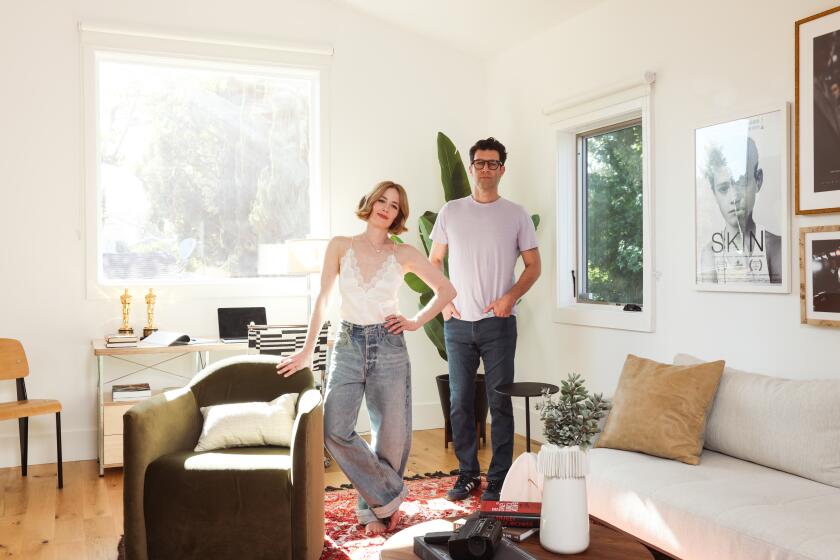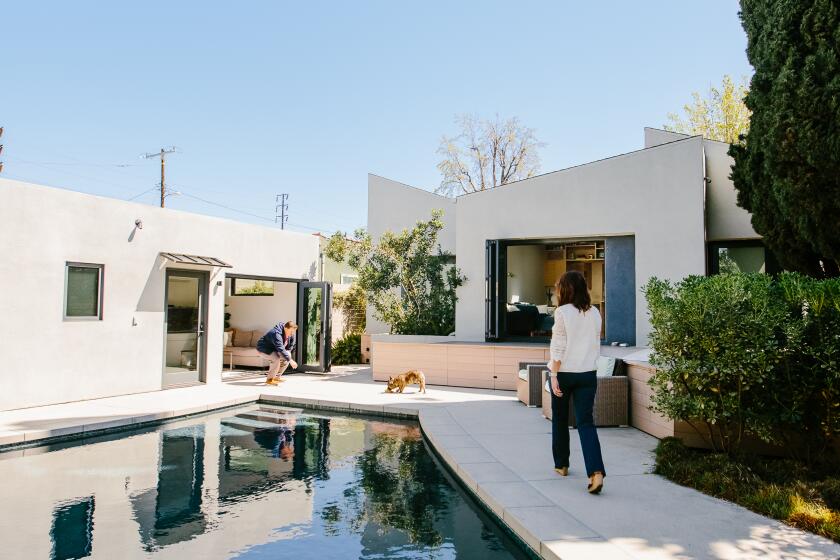Curb, and pocket, appeal
THE last days of Karrie Jacobs’ tenure as the founding editor of Dwell had been difficult. Her passion for the principles of Modernism -- not what she calls “the self-consciously historic style it has become” -- was losing its place within her own pages. “There was increasing pressure to show really high-end houses,” she says, “and less room for features that weren’t about product.”
After a fractious departure from the magazine, Jacobs still struggled with a fundamental question that, she says, too many shelter magazines were avoiding: Is there such a thing as a home that’s thoughtfully designed, well engineered and yet still affordable?
For the record:
12:00 a.m. July 30, 2006 For The Record
Los Angeles Times Sunday July 30, 2006 Home Edition Main News Part A Page 2 National Desk 1 inches; 48 words Type of Material: Correction
Affordable construction: An article in Thursday’s Home on author Karrie Jacobs included a quote from her book, in which she describes the LV Home in Perryville, Mo., as “a seamless galvanized aluminum box with generous windows.” The house’s exterior siding is actually steel coated in an aluminum-zinc alloy.
For The Record
Los Angeles Times Thursday August 03, 2006 Home Edition Home Part F Page 7 Features Desk 1 inches; 50 words Type of Material: Correction
Affordable construction: An article in last week’s Home section on author Karrie Jacobs included a quote from her book, in which she describes the LV Home in Perryville, Mo., as “a seamless galvanized aluminum box with generous windows.” The house’s exterior siding is actually steel coated in an aluminum-zinc alloy.
On the morning of July 4, 2003, she drove her midnight blue Cabrio convertible out of New York and set out on a journey that would end up covering 14,000 miles. Her mission: to find the perfect $100,000 house.
Jacobs thought her ideal home would be designed with the best Modernist principles in mind. “This meant using materials not so much for how they look as how they perform,” she says during a recent interview in her cluttered Brooklyn apartment. “It was thinking about the qualities of light and space, how the house is positioned in relation to the sun. Ultimately it was about thinking carefully through a building.” It would be a search for an American dream that seemed to have all but faded.
By the time her road trip was over, Jacobs, 48, had discovered the answer to her question: Yes, an architecturally interesting home could be built for $100,000. Yet she found herself facing a more daunting mystery: Why did the search prove so difficult?
JACOB’S first stop was a two-week do-it-yourself home-building workshop at Yestermorrow, a “design/build” school in Warren, Vt. Here she learned the essentials of drafting and picked up a hammer to work on a small construction site. Absorbing the values of the building pragmatist was a valuable lesson as Jacobs drove on, meeting architects from across the Midwest, Mississippi, Colorado, California -- all the while documenting her search for “The Perfect $100,000 House: A Trip Across America and Back in Pursuit of a Place to Call Home,” to be published next month by Viking.
In Perryville, Mo., the author found Rocio Romero, who was erecting a prototype of her LV Home, “a seamless, galvanized aluminum box with generous windows that, inside and out, speaks of a high-tech modernity,” Jacobs wrote. The home also met Jacobs’ main criterion, with construction costs (excluding land) less than $100,000.
In Lawrence, the Studio 804 design program run by the University of Kansas architecture school had recently built a pair of steel-clad boxes topped by wild-looking plastic roofs for $95,000. With the sun’s rays streaming through clerestory windows, Jacobs confessed in her book, “I walk into this light-filled wonder and it makes me thankful that I’m no longer a shelter magazine editor.” The family who owns this “perfect piece of architecture,” she adds with relief, has filled it with items you rarely see in magazine spreads: the mundane, messy possessions of real life. (Dwell owner and founder Lara Hedberg Deam did not respond to requests for comment about Jacobs or her critique of design media.)
On Fox Island, across from Tacoma, Wash., Jacobs visited a brilliant house defined by its high, curved roof and zebra-striped siding. Designed by Anderson Anderson Architects and constructed for less than $90,000, the structure is in essence a two-story shed with a wall composed almost entirely of glass.
Between visits with 23 architects, Jacobs’ conception of the perfect house changed. It was no longer pristinely Modernist, but rather more contemporary in its vernacular. She assumed that it would be built somewhere exotic -- maybe the San Juan Islands. It came as a shock that she would ultimately find her perfect house in Texas, in the humble Houston suburb of Eastwood.
There she met residential designer Brett Zamore, 35, who was in the early stages of constructing a house he called the Shot-Trot, a cross between the Southern style known as “shotgun” and the Texas Hill Country archetype, “dog trot,” which has breezeways running from one side of the house to the other.
Late last year, Jacobs returned to see the Shot-Trot completed. “Brett took me there at night,” she says. “I thought maybe this was one of those architects’ tricks showing off a house glowing like a lantern, but in fact it was beautiful.”
With a starkly pitched roof and cement-based cladding, it was hardly a model of classical Modernism. “But it had an authenticity about it,” she says, adding that she has come to love its balance between traditional and modern.
Since Jacobs’ last visit, Zamore developed three versions of the house to be sold in kit form.
“They are not prefab,” the designer insists. “Rather, the kits are shipped to the site and assembled by builders.” The homes can be built for $100 to $110 a square foot (excluding land costs), which fit Jacobs’ criteria. Zamore has sought contracts in areas affected by Hurricane Katrina. If successful, he could fulfill one of Jacobs’ dearest hopes: the smart, affordable house that is mass-produced.
For Jacobs, the Shot-Trot house was significant for another reason. It had a quality she found missing during so much of her journey: modesty.
“Right now in America there seems to be ‘rich people’s housing’ and ‘poor people’s housing,’ ” she says. “It always seemed to me that ‘in between’ was what this country was supposed to be all about. And in my search for that ‘in-between,’ I thought Zamore struck exactly the right note.”
SINCE Jacobs’ trip, construction costs have risen but the absence of modesty in contemporary homes hasn’t changed. “The American family has gotten smaller but our houses have grown larger,” says Jacobs, architecture critic for New York magazine before she joined Dwell. “Yes, we all have more stuff -- the storage industry is booming -- and our cars are bigger, but still our houses never seem big enough.”
After the Brooklyn interview, Jacobs heads for vacation in Bridgehampton, N.Y., where she is sharing a tiny one-room house with friends. The sprawling McMansions nearby, most of them second homes, “have nothing to do with necessity, not much to do with lifestyle.” A home, she says, “isn’t a home any more.” It’s an investment, and there is a psychology that says ‘the bigger the house, the better the investment.’ ”
It doesn’t have to be so, she says, even for a high-priced market such as Southern California.
“The key is to find an architect who really thinks about how to build inexpensively, who specializes in it and, above all,” she says, “who’s passionate about it.” Start with a level lot, she says, “and build where your neighbors are not going to be up in arms about something unconventional appearing in their midst.”
Jacobs still wants to design and construct her dream house. Last year, however, she moved into the penthouse floor of a mustard-colored, glazed-brick building in Brooklyn whose hallways she describes as “vintage Marriott.” Inside a 550-square-foot pad, classic pieces of Modernist furniture vie for space with rows of sneakers and piles of papers. She says little delights her more than sitting by the window in her red Giorgio Cazzaniga chair, reading a book and glancing out at the Statue of Liberty off in the distance.
It is more a writer’s retreat than Modernist showcase. Nonetheless, fighting to live comfortably within its cramped confines has inspired a new dream. First she thought it would be the concept for her future house. Then she saw it as the idea for a new magazine. “It’s to be titled Minimum,” she says. “I already have the tag line: ‘Less is the new more.’ ”
David Hay can be reached at home@latimes.com.
*
(BEGIN TEXT OF INFOBOX)
The building blocks of affordable construction
Building a $100,000 house requires homeowners to experiment, compromise and, at times, sacrifice, according to designers in Karrie Jacobs’ forthcoming book. Some considerations and advice from residential designer Brett Zamore (www.brettzamoredesign.com) and University of Kansas architecture professor Dan Rockhill (www.rockhillandassociates.com):
Work fast. Shortening the construction time will reduce new construction loan costs.
Buy flat land. Location is critical. Think about ease of access.
Face south. Try to find a lot that maximizes the south exposure. Good architects can use that orientation in their design to save on energy costs in most parts of the country.
Use standard components. Reducing the number of customized components may drastically reduce costs.
Be realistic. Do not assume that recycled materials are cheaper, and don’t be surprised if the look of the house evolves from the need for economy rather than an aesthetic vision.
Know the rules. Be careful of covenants set up by subdivisions to keep nontraditional designers and builders from producing homes that look different.
Think long term. People calculate immediate expenses rather than long-term issues such as energy bills and the lifespan of building materials. Ultimately, the solutions might be living modestly and thinking smaller.
--From Times staff



